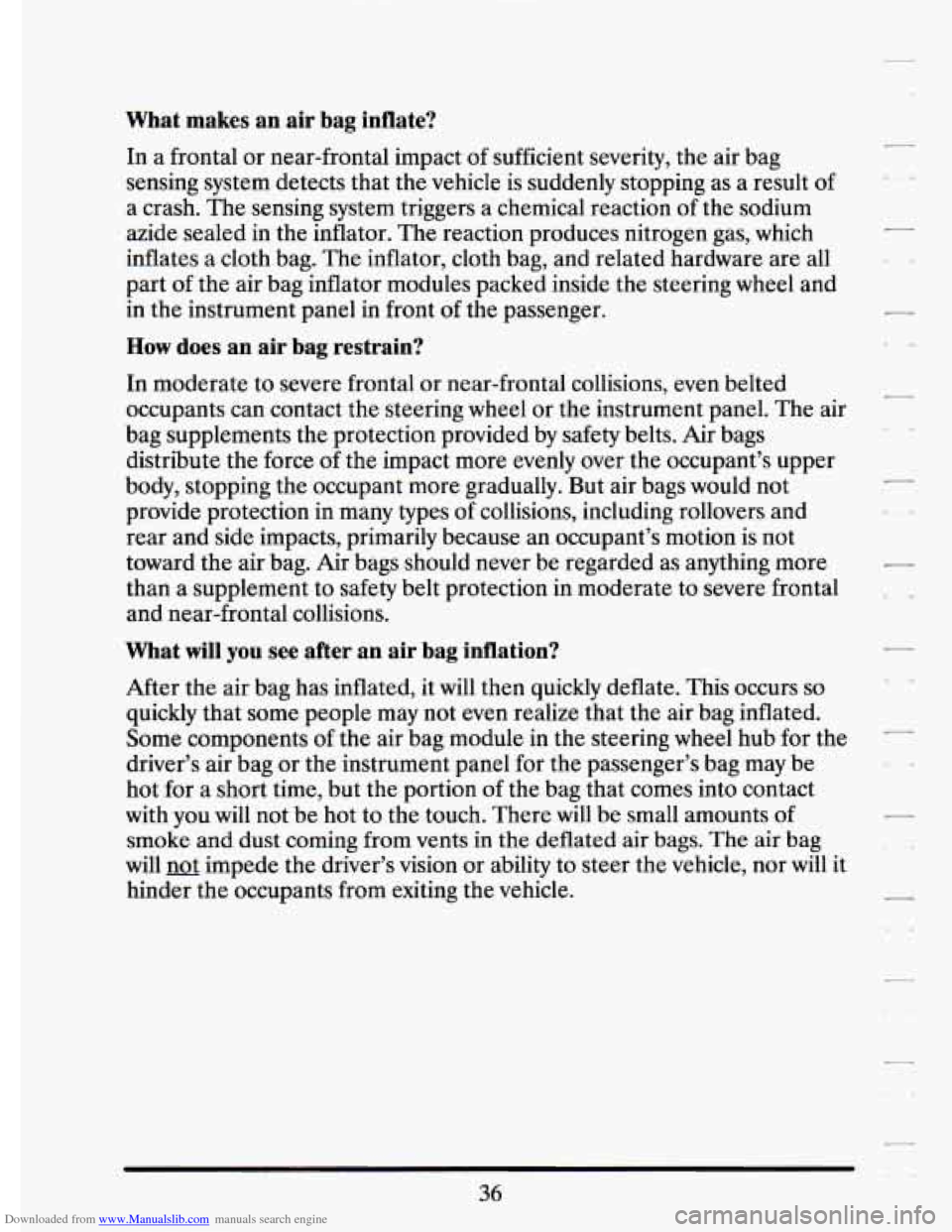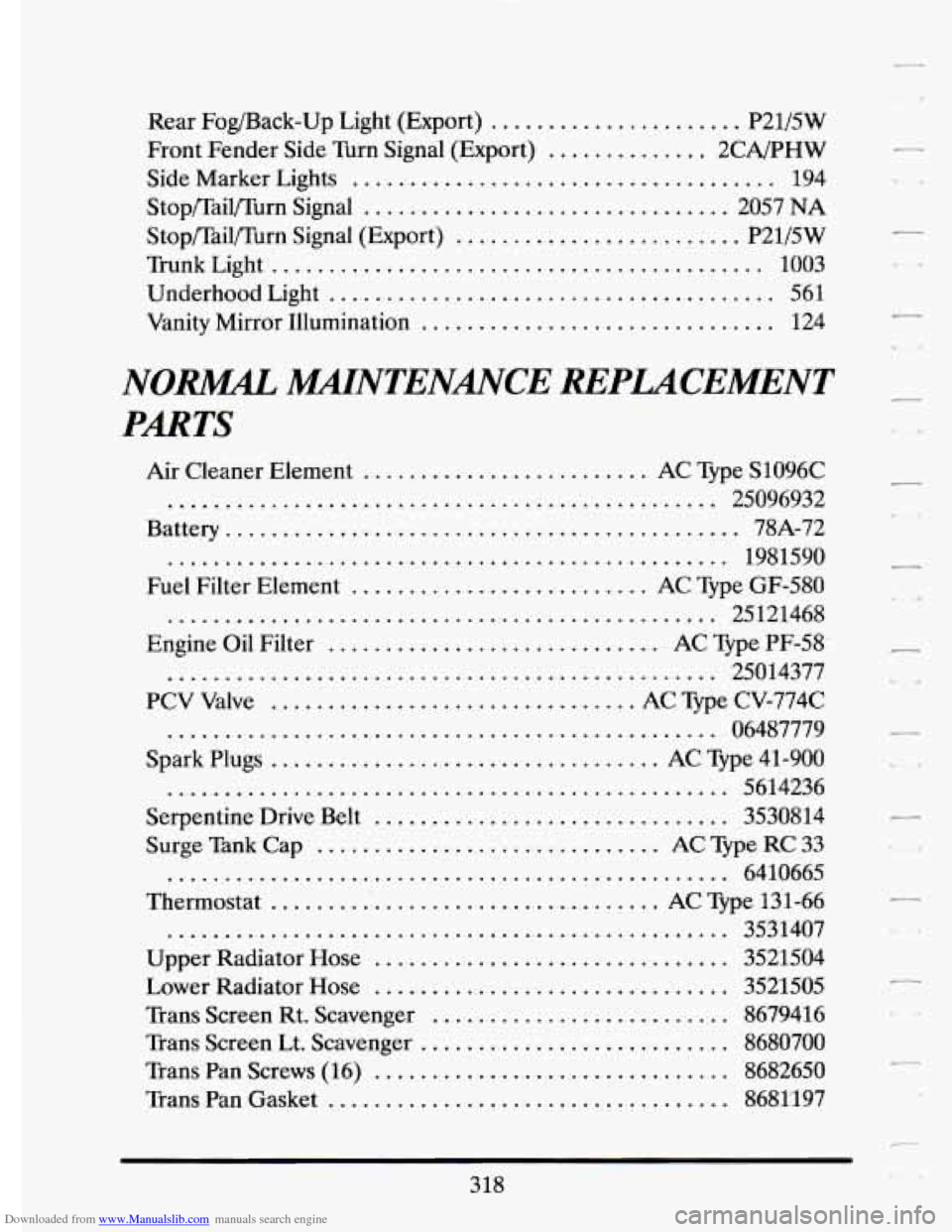1994 CADILLAC ELDORADO gas type
[x] Cancel search: gas typePage 48 of 398

Downloaded from www.Manualslib.com manuals search engine What makes an air bag inflate?
In a frontal or near-frontal impact of sufficient severity, the air bag
sensing system detects that the vehicle is suddenly stopping as\
a result of
a crash. The sensing system triggers a chemical reaction of the sodium
azide sealed
in the inflator. The reaction produces nitrogen gas, which
inflates a cloth bag. The inflator, cloth bag, and related hardware are all
part
of the air bag inflator modules packed inside the steering wheel and
in the instrument panel in front of the passenger.
How does an air bag restrain?
In moderate to severe frontal or near-frontal collisions, even belted
occupants can contact the steering wheel or the instrument panel. The air
bag supplements the protection provided by safety belts. Air bags
distribute the force of the impact more evenly over the occupant’s upper
body, stopping the occupant more gradually. But air bags would not
provide protection in many types
of collisions, including rollovers and
rear and side impacts, primarily because an occupant’s motion is \
not
toward the air bag. Air bags should never be regarded as anything more
than a supplement to safety belt protection
in moderate to severe frontal
and near-frontal collisions.
What will you see after an air bag inflation?
After the air bag has inflated, it will then quickly deflate. This occur\
s so
quickly that some people may not even realize that the air bag inflated.
Some components of the air bag module
in the steering wheel hub for the
driver’s air bag or the instrument panel for the passenger’s bag may be
hot for a short time, but the portion of the bag that comes into contact
with you will not be hot to the touch. There will be small amounts of
smoke and dust coming from vents in the
deflated air bags. The air bag
will
not impede the driver’s vision or ability to steer the vehicle, nor will it
hinder the occupants from exiting the vehicle.
36
Page 256 of 398

Downloaded from www.Manualslib.com manuals search engine FUELS IN FOREIGN COUNTNES
If you plan on driving in another country outside the U.S. or Canada,
unleaded fuel may be hard to find.
Do not use leaded gasoline. If you use
even one tankful, your emission controls won’t work
well or at all. With
continuous use, spark plugs can get fouled, the exhaust system can
corrode, and your engine oil can deteriorate quickly. Your vehicle’s
oxygen sensor will be damaged. All of that means costly repairs that
wouldn’t be covered by your warranty.
To check on fuel availability, ask an auto club, or contact a major oil
company that does business in the country where you’ll be driving.
You can also write us at the following address for advice. Just tell us
where you’re going and give your Vehicle Identification Numbe\
r (VIN).
General Motors Overseas Distribution Corporation,
North American Export Sales
(NAES)
1908 Colonel Sam Drive
Oshawa, Ontario
L1H 8P7
FUEL ECONOMY
Your fuel economy (miles per gallon or liters per 100 kilometers) can vary
depending on how your Cadillac is driven. Several vehicles like yours
have been driven through a standard test and their actual fuel econ\
omy
was recorded. These readings were adjusted and printed on the fuel
economy window sticker which was attached
to your new Cadillac when it
was delivered and in the Gas Mileage Guide which is available from your
dealership.
The fuel economy estimates are based on results of tests required by the
U. S. Environmental Protection Agency (EPA). These tests are used to
certify that vehicles meet the Federal emissions and fuel economy
standards. Cadillac tests prototypes of new vehicles and submits the
results to the EPA. The EPA then confirms the accuracy of
the figures
provided by Cadillac. The vehicles are driven by a professional driver
under controlled laboratory conditions, on an instrument similar \
to
a
treadmill. These procedures ensure that each vehicle is tested under
identical conditions.
244
Page 330 of 398

Downloaded from www.Manualslib.com manuals search engine Rear Fog/Back-Up Light (Export) ...................... P21/5W
Side Marker Lights
..................................... 194
Stop/Tail/Turn Signal
................................ 2057 NA
Stop/Tail/Turn Signal (Export) ......................... P21/5W
Front Fender
Side Turn Signal (Export)
.............. 2CNPHW
Trunk Light
.........................
Underhood Light ....................
Vanity Mirror Illumination ............
NORlMAL M4INTENNrE
PARTS
Air Cleaner Element .................
Battery .............................
Fuel Filter Element ..................
Engine Oil Filter ....................
PCVValve .........................
Spark Plugs .........................
Serpentine Drive Belt ................
Surge Tank Cap .....................
Thermostat ..........................
Upper Radiator Hose ................
Lower Radiator Hose ................
Trans Screen Rt. Scavenger ...........
Trans Screen Lt. Scavenger ............
Trans Pan Screws (16) ................
Trans Pan Gasket ....................
..................................
..................................
..................................
..................................
..................................
..................................
..................................
..................................
.................. 1003
................... 561
................... 124
REPLACEMENT
........ AC Type S1096C
.............. 25096932
................ 78A-72
............... 1981590
.............. 25121468
.............. 25014377
.............. 06487779
............... 5614236
............... 3530814
......... AC Type RC 33
............... 6410665
......... ACType 131-66
............... 3531407
............... 3521504
............... 3521505
............... 8679416
............... 8680700
............... 8682650
............... 8681197
........ AC Type GF-580
......... AC Type PF-58'
....... AC Type CV-774C
......... AC Type 41-900
318